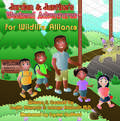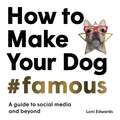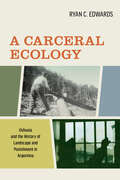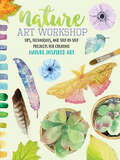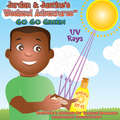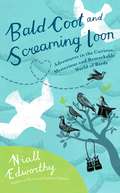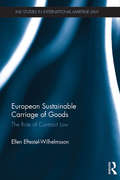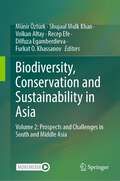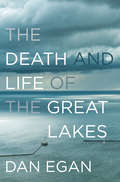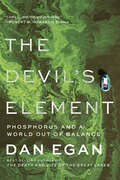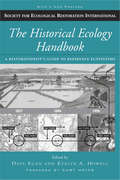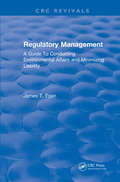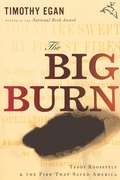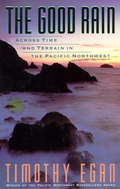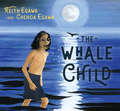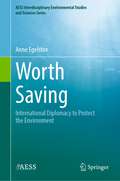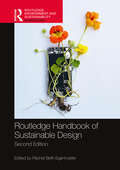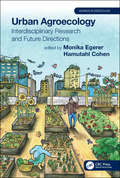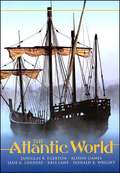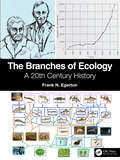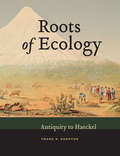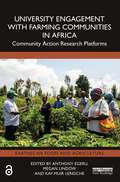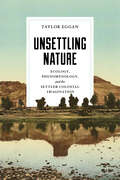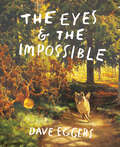- Table View
- List View
Jordan & Justine's Weekend Adventures: Wildlife Parts 1 & 2
by Latoya Edwards Tanille EdwardsJordan & Justine's Weekend AdventuresTM: Wildlife Parts 1 & 2 brings children right into the center of animal life at a wildlife conservation center. The brother and sister pair, Jordan & Justine, and their two friends, Raj and Ling, learn how koalas live, what it means when an animal is said to be endangered, and how humans can help. Jordan and Justine use their magical powers to explore the world of dolphins, to find out how laws can protect wildlife, and to learn what it means to be a mammal. Perfect for children ages 7 to 9. Also look for Jordan & Justine's Weekend AdventuresTM: Plants Parts 1 & 2, ISBN: 978-0-9787302-4-6, at your local bookstore or online at retailers everywhere. Children love to explore plant growth, healthy eating habits, and photosynthesis with Jordan and Justine in this fun book!
How To Make Your Dog #Famous: A Guide to Social Media and Beyond
by Loni EdwardsYou know your dog is the cutest but does everyone else know it too?In this book, Loni Edwards, the human behind the world's most influential pets, breaks down the path to fame. Discover insights into the success of social media's top pups and follow the essential steps on the road to fame - from crafting your brand to advocating for your pup on set. With expert guidance on how to be a good dog parent and make sure your pup is happy and healthy every step of the way, this is your one-stop guide to helping your dog win over hearts, one adorable post at a time.Featuring the stories of more than 40 of the most successful pet influencers:157 of Gemma, Amazing Graciedoodle, Barkley Sir Charles, Bertie Bert the Pom, Bronson the Bully, Brussels Sprout, Bully Baloo, Charlie the Black Shepherd, Chloe the Mini Frenchie (& Emma Bear), Coco the Maltese Dog (Coco & Cici), Cookie Malibu, Crusoe the Celebrity Dachshund, Daily Dougie, Dog named Stella, Ducky the Yorkie, Frame the Weim, Gone to the Snow Dogs, Harlow and Sage, Hi Wiley, Kelly Bove, Lilybug, Lizzie Bear, Louboutina the Hugging Dog, Maya Polar Bear, Mervin the Chihuahua, Milo and Noah, MJ the Beagle, Mr. Biggie, Popeye the Foodie, Puggy Smalls, Reagandoodle, Remix the Dog, Rocco Roni, Super Corgi Jojo, Super Scooty, Tatum, That Goldendoodle, The Bike Dog, Tika the Iggy, Tuna Melts my Heart, Tupey the Borzoi, Verpinscht, Winnie the Cocker, Wolfgang 2242
How To Make Your Dog #Famous: A Guide to Social Media and Beyond
by Loni EdwardsYou know your dog is the cutest but does everyone else know it too?In this book, Loni Edwards, the human behind the world's most influential pets, breaks down the path to fame. Discover insights into the success of social media's top pups and follow the essential steps on the road to fame - from crafting your brand to advocating for your pup on set. With expert guidance on how to be a good dog parent and make sure your pup is happy and healthy every step of the way, this is your one-stop guide to helping your dog win over hearts, one adorable post at a time.Featuring the stories of more than 40 of the most successful pet influencers:157 of Gemma, Amazing Graciedoodle, Barkley Sir Charles, Bertie Bert the Pom, Bronson the Bully, Brussels Sprout, Bully Baloo, Charlie the Black Shepherd, Chloe the Mini Frenchie (& Emma Bear), Coco the Maltese Dog (Coco & Cici), Cookie Malibu, Crusoe the Celebrity Dachshund, Daily Dougie, Dog named Stella, Ducky the Yorkie, Frame the Weim, Gone to the Snow Dogs, Harlow and Sage, Hi Wiley, Kelly Bove, Lilybug, Lizzie Bear, Louboutina the Hugging Dog, Maya Polar Bear, Mervin the Chihuahua, Milo and Noah, MJ the Beagle, Mr. Biggie, Popeye the Foodie, Puggy Smalls, Reagandoodle, Remix the Dog, Rocco Roni, Super Corgi Jojo, Super Scooty, Tatum, That Goldendoodle, The Bike Dog, Tika the Iggy, Tuna Melts my Heart, Tupey the Borzoi, Verpinscht, Winnie the Cocker, Wolfgang 2242
A Carceral Ecology: Ushuaia and the History of Landscape and Punishment in Argentina
by Ryan C. EdwardsCloser to Antarctica than to Buenos Aires, the port town of Ushuaia, Argentina is home to a national park as well as a museum that is housed in the world’s southernmost prison. Ushuaia’s radial panopticon operated as an experimental hybrid penal colony and penitentiary from 1902 to 1947, designed to revolutionize modern prisons globally. A Carceral Ecology offers the first comprehensive study of this notorious prison and its afterlife, documenting how the Patagonian frontier and timber economy became central to ideas about labor, rehabilitation, and resource management. Mining the records of penologists, naturalists, and inmates, Ryan C. Edwards shows how discipline was tied to forest management, but also how inmates gained situated geographical knowledge and reframed debates on the regeneration of the land and the self. Bringing a new imperative to global prison studies, Edwards asks us to rethink the role of the environment in carceral practices as well as the impact of incarceration on the natural world.
Nature Art Workshop: Tips, Techniques, and Step-by-Step Projects for Creating Nature-Inspired Art
by Sarah Lorraine Edwards Mikko Sumulong Alyssa Stokes Katie BrooksA visual resource for artists and crafters who want to combine their talents with their love of the natural world.Each page of Nature Art Workshop engages, inspires, and encourages artists to see the world around them in a new light while they learn to create their own nature-inspired art.Four talented visual nature artists guide you through finding and prepping traditional media and natural elements to use in creating unique nature-inspired projects, following simple step-by-step instructions. Projects include a pressed-flower ceramic dish, fresh floral crown, and flower-adorned candles, in addition to painted feathers, stones, shells, leaves, and more. Valuable art tips and techniques offer guidance during the artistic process.A fun, refreshing approach to mixed-media art, Nature Art Workshop proves that you can turn anything into a stunning work of art with the right materials and a bit of imagination.
Jordan & Justine's Weekend Adventures: Go Go Green
by Tanille EdwardsJordan & Justine's Weekend AdventuresTM: Go Go Green takes children on an exciting, high-flying adventure as they learn to go green. Jordan and Justine are part of a Go Go Green campaign in their community, and they teach young readers about the environment, how to take steps to save energy, how to participate in their community, and why it is important to care about the earth! The multicultural cast of characters in this book explore how Native American culture uses the environment for resources and how modern living affects the environment. Children will also learn new words in Spanish. Also look for Jordan & Justine's Weekend Adventures: Wildlife Parts 1 & 2, ISBN: 978-0-9787302-4-6 & Jordan & Justine's Weekend Adventures: Plants Parts 1 & 2, ISBN: 978-0-9787302-4-6
Bald Coot and Screaming Loon
by Niall EdworthyFrom the author of The Curious Gardener's Almanac, a fascinating miscellany that explores the mysterious world of birds. Comprising more than 1,000 entries of remarkable information about birds, bird life, and bird-watching, Bald Coot and Screaming Loon reveals the intriguing evolution and behavior patterns of these avian creatures. Woven into this wealth of knowledge are quotations, anecdotes, traditional sayings, lines of verse, practical advice for attracting and spotting birds, and words of rural wisdom, covering such topics as: ?How birds came to be ?Courtship and breeding ?Why birds sing and call ?Avian anatomy ?Birds and man ?How and why birds fly ?The mystery of migration ?Bird Brains: Instinct or intelligence? ?How birds cope in a damaged world
European Sustainable Carriage of Goods: The Role of Contract Law (IMLI Studies in International Maritime Law)
by Ellen Eftestøl-WilhelmssonThis work discusses the rapidly developing European transport policy on sustainable freight and the connected efforts initiated by the European Commission (EC) on greening transport by the means of contract law. Greening transport has been a central goal for the EU for decades. The main problem has been, and still is, that far too much carriage of goods within the EU is performed unimodally: by road carriage alone. This has caused severe problems particularly in central Europe, where both trade and environment is suffering from an ineffective transport industry with growing problems of congestion and pollution. A modal shift in transport from mainly road based to a form of transport in which more environmental friendly modes such as rail, inland waterways and sea born transport are integrated into one transport chain, is hence an objective of the EU. If successful, this model could then be extended to the international transport community. The key question raised in this book is whether the traditional role of contract law is changing to such an extent that the parties involved must take external interests into account. In the case of the EU’s efforts to enhance sustainable carriage of goods within its realm, the author explores whether governmental interference is necessary, or if we can trust that the parties will integrate environmental issues into their contracts because there is a demand for such clauses. The different proposals for an EU regime on multimodal contracts of carriage are discussed in this context. This book will be of great relevance to academics and practitioners with an interest in EU law, transport law, environmental law and maritime law in general.
Biodiversity, Conservation and Sustainability in Asia: Volume 2: Prospects and Challenges in South and Middle Asia
by Dilfuza Egamberdieva Münir Öztürk Recep Efe Volkan Altay Shujaul Mulk Khan Furkat O. KhassanovOf the world’s seven continents, Asia is the largest. Its physical landscapes, political units, and ethnic groups are both wide-ranging and many. Southwest, South and Middle Asia are highly populated regions which, as a whole, cover an extremely large area of varied geography. In total, this domain is unique in its plant diversity and large vegetation zones with different communities and biomes. It is rich in endemics, with specific and intraspecific diversity of fruit trees and medicinal plants, including a number of rare, high value, species. At the same time, much of the land in the region is too dry or too rugged, with many geographical extremes. Overgrazing, oil and mineral extraction, and poaching are the major threats in the area. This two-volume project focuses on the dynamic biodiversity of the region with in-depth analysis on phytosociology, plants, animals and agroecology. There are also chapters that explore new applications as well as approaches to overcome problems associated with climate change. Much of the research and analysis are presented here for the first time. We believe this work is a valuable resource for professionals and researchers working in the fields of plant diversity and vegetation, animal diversity and animal populations, and geo-diversity and sustainable land use, among others.The first volume guides our readers to West Asia and the Caucasus region, while volume two focuses on issues unique to South and Middle Asia.
The Death and Life of the Great Lakes
by Dan Egan<P>A landmark work of science, history and reporting on the past, present and imperiled future of the Great Lakes. <P>The Great Lakes—Erie, Huron, Michigan, Ontario and Superior—hold 20 percent of the world’s supply of surface fresh water and provide sustenance, work and recreation for tens of millions of Americans. But they are under threat as never before, and their problems are spreading across the continent. <P>The Death and Life of the Great Lakes is prize-winning reporter Dan Egan’s compulsively readable portrait of an ecological catastrophe happening right before our eyes, blending the epic story of the lakes with an examination of the perils they face and the ways we can restore and preserve them for generations to come. <P>For thousands of years the pristine Great Lakes were separated from the Atlantic Ocean by the roaring Niagara Falls and from the Mississippi River basin by a “sub-continental divide.” Beginning in the late 1800s, these barriers were circumvented to attract oceangoing freighters from the Atlantic and to allow Chicago’s sewage to float out to the Mississippi. These were engineering marvels in their time—and the changes in Chicago arrested a deadly cycle of waterborne illnesses—but they have had horrendous unforeseen consequences. <P> Egan provides a chilling account of how sea lamprey, zebra and quagga mussels and other invaders have made their way into the lakes, decimating native species and largely destroying the age-old ecosystem. And because the lakes are no longer isolated, the invaders now threaten water intake pipes, hydroelectric dams and other infrastructure across the country. <P>Egan also explores why outbreaks of toxic algae stemming from the overapplication of farm fertilizer have left massive biological “dead zones” that threaten the supply of fresh water. He examines fluctuations in the levels of the lakes caused by manmade climate change and overzealous dredging of shipping channels. And he reports on the chronic threats to siphon off Great Lakes water to slake drier regions of America or to be sold abroad. <P>In an age when dire problems like the Flint water crisis or the California drought bring ever more attention to the indispensability of safe, clean, easily available water, The Death and the Life of the Great Lakes is a powerful paean to what is arguably our most precious resource, an urgent examination of what threatens it and a convincing call to arms about the relatively simple things we need to do to protect it.
The Devil's Element: Phosphorus And A World Out Of Balance
by Dan EganA New Yorker Best Book of the Year "Lively…and thought-provoking.” —Robert W. Howarth, Science The New York Times best-selling author on the source of great bounty—and now great peril—all over the world. Phosphorus has played a critical role in some of the most lethal substances on earth: firebombs, rat poison, nerve gas. But it’s also the key component of one of the most vital: fertilizer, which has sustained life for billions of people. In this major work of explanatory science and environmental journalism, Pulitzer Prize finalist Dan Egan investigates the past, present, and future of what has been called “the oil of our time.” The story of phosphorus spans the globe and vast tracts of human history. First discovered in a seventeenth-century alchemy lab in Hamburg, it soon became a highly sought-after resource. The race to mine phosphorus took people from the battlefields of Waterloo, which were looted for the bones of fallen soldiers, to the fabled guano islands off Peru, the Bone Valley of Florida, and the sand dunes of the Western Sahara. Over the past century, phosphorus has made farming vastly more productive, feeding the enormous increase in the human population. Yet, as Egan harrowingly reports, our overreliance on this vital crop nutrient is today causing toxic algae blooms and “dead zones” in waterways from the coasts of Florida to the Mississippi River basin to the Great Lakes and beyond. Egan also explores the alarming reality that diminishing access to phosphorus poses a threat to the food system worldwide—which risks rising conflict and even war. With The Devil’s Element, Egan has written an essential and eye-opening account that urges us to pay attention to one of the most perilous but little-known environmental issues of our time.
The Historical Ecology Handbook: A Restorationist's Guide to Reference Ecosystems (Science Practice Ecological Restoration)
by Dave Egan Curt Meine Evelyn A. HowellThe Historical Ecology Handbook makes essential connections between past and future ecosystems, bringing together leading experts to offer a much-needed introduction to the field of historical ecology and its practical application by on-the-ground restorationists.Chapters present individual techniques focusing on both culturally derived evidence and biological records, with each chapter offering essential background, tools, and resources needed for using the technique in a restoration effort. The book ends with four in-depth case studies that demonstrate how various combinations of techniques have been used in restoration projects.The Historical Ecology Handbook is a unique and groundbreaking guide to determining historic reference conditions of a landscape. It offers an invaluable compendium of tools and techniques, and will be essential reading for anyone working in the field of ecological restoration.
Regulatory Management: A Guide To Conducting Environmental Affairs and Minimizing Liability
by James T. EganRegulatory Management: A Guide to Conducting Environmental Affairs and Minimizing Liability emphasizes the importance of establishing a proactive approach to permit negotiation and compliance. This book is an important guide to conducting environmental affairs and minimizing liability. This book is a "must have" book for anyone responsible for regulatory compliance/management - private industry, environmental consultants, university officials, environmental engineers, environmental attorneys.Public and political concern about the environment has grown at a phenomenal rate over the last several years. Not since the early 1970s has there been such emphasis on reducing pollution. Congress and the Environmental Protection Agency have responded by enacting tough new legislation and increasing enforcement activities. Industry, utilities, and other entities that continue to discharge must invest millions of dollars in advanced waste treatment or face heavy fines or liability.In 10 detailed chapters, the author explains how to establish cooperative partnerships with politicians and regulators, create solution-oriented strategies using legal and technical permit insights, allocate resources to provide maximum environmental protection at minimum cost, reduce accidents and errors through training programs and procedure documentation, and influence the regulatory process to win practical and achievable permit limits. The book also shows you how to increase public credibility and manage the media, track treatment operations to provide a strong defense in the event of litigation, and keep up with new regulations and new technologies. The book is designed to help its readers set into motion the processes that will develop real solutions to environmental/regulatory challenges and will assist in developing an active and proactive management style that focuses on results as it minimizes liability.
The Big Burn: Teddy Roosevelt and the Fire that Saved America (Playaway Adult Nonfiction Ser.)
by Timothy EganNational Book Award-winner Timothy Egan turns his historian's eye to the largest-ever forest fire in America and offers an epic, cautionary tale for our time. On the afternoon of August 20, 1910, a battering ram of wind moved through the drought-stricken national forests of Washington, Idaho, and Montana, whipping the hundreds of small blazes burning across the forest floor into a roaring inferno that jumped from treetop to ridge as it raged, destroying towns and timber in the blink of an eye. Forest rangers had assembled nearly ten thousand men to fight the fires, but no living person had seen anything like those flames, and neither the rangers nor anyone else knew how to subdue them. Egan recreates the struggles of the overmatched rangers against the implacable fire with unstoppable dramatic force, and the larger story of outsized president Teddy Roosevelt and his chief forester, Gifford Pinchot, that follows is equally resonant. Pioneering the notion of conservation, Roosevelt and Pinchot did nothing less than create the idea of public land as our national treasure, owned by every citizen. Even as TR's national forests were smoldering they were saved: The heroism shown by his rangers turned public opinion permanently in favor of the forests, though it changed the mission of the forest service in ways we can still witness today.
The Good Rain: Across Time and Terrain in the Pacific Northwest (Vintage Departures)
by Timothy EganTimothy Egan describes his journeys in the Pacific Northwest through visits to salmon fisheries, redwood forests and the manicured English gardens of Vancouver. Here is a blend of history, anthropology and politics.
The Whale Child
by Keith Egawa Chenoa EgawaAn inspiring middle-grade chapter book that introduces young readers to the environmental challenges facing the planet through the eyes of Coast Salish characters and authors."You have family on land as you do in the sea. . . being a caretaker of the earth begins with taking care of the water that all life depends on."Shiny is a whale child. One day his mother teaches him about the harm facing the world's oceans because of human carelessness. Shiny agrees to be turned into a boy by the ocean's water spirit so he can visit the land and alert people to these dangers. He meets Alex, a young Coast Salish girl who learns from Shiny that the living spirit of water exists in everything--glaciers, rivers, oceans, rain, plants, and all living creatures. Together the two travel the earth, confronting the realities of a planet threatened by an uncertain future. Inspired by Shiny's hope, humor, and wisdom, Alex makes the promise to become a teacher for future generations. She realizes that the timeless Indigenous value of environmental stewardship is needed now more than ever and that we must all stand up on behalf of Mother Earth. Written and illustrated by Indigenous authors Keith Egawa and Chenoa Egawa, The Whale Child introduces children ages 7 to 12 to existing environmental issues with a message of hope, education, sharing, and action. Ideal for middle-grade readers who are beginning to read chapter books on their own, this book also includes resources for students and teachers to facilitate learning about Pacific Northwest Indigenous cultures and the environment.
Worth Saving: International Diplomacy to Protect the Environment (AESS Interdisciplinary Environmental Studies and Sciences Series)
by Anne EgelstonThis textbook is intended to be used in an upper-level international environmental issues class as part of the American Environmental Studies and Sciences book series. This class is commonly taught at both the undergraduate and graduate level as part of either an environmental studies program, a political science program, or within a policy track of an environmental science program.Given the length of time that negotiations have occurred, a new generation of students and practitioners will need to understand the complex processes that produced many of our environmental treaties. The majority of the students in environmental studies do not have a background in political science. Moving from a political science approach to an interdisciplinary approach will benefit the students by making the material more accessible.As these fields continue to grow and develop, regulatory compliance becomes increasingly important. Thus, this book is aimed at adding a business and industry perspective to this field where appropriate.
Routledge Handbook of Sustainable Design (Routledge Environment and Sustainability Handbooks)
by Rachel Beth EgenhoeferThe Routledge Handbook of Sustainable Design considers the design, not only of artifacts, but of structures, systems, and interactions in the context of sustaining our shared planet. This revised edition introduces new and updated chapters, as well as a new section on pedagogy for sustainable design. With authors from around the world, design is positioned in context with recent crises such as global pandemics, racial reckoning, political unrest, and natural disasters. Just as design is an interdisciplinary field, the climate crisis is deeply tangled in racial justice, gender justice, global health, economics, trade, and more. Divided into six sections, it presents a holistic approach to understanding the many facets of sustainable design: Part 1: Systems and Design Part 2: Complexities of Sustainable Design Part 3: Community Engaged Design for Local and Global Diversity Part 4: Design for Sustainable Behaviors Part 5: Design Futures Part 6: Pedagogy in Design for Sustainability Arguing that design needs to restore, regenerate, and rejuvenate our planet and people, this handbook will be invaluable to researchers, students, and practitioners across all subdisciplines of design, architecture, business, energy management, visual arts, and environmental studies, among others.
Urban Agroecology: Interdisciplinary Research and Future Directions (Advances in Agroecology #23)
by Monika Egerer Hamutahl CohenToday, 20 percent of the global food supply relies on urban agriculture: social-ecological systems shaped by both human and non-human interactions. This book shows how urban agroecologists measure flora and fauna that underpin the ecological dynamics of these systems, and how people manage and benefit from these systems. It explains how the sociopolitical landscape in which these systems are embedded can in turn shape the social, ecological, political, and economic dynamics within them. Synthesizing interdisciplinary approaches in urban agroecology in the natural and social sciences, the book explores methodologies and new directions in research that can be adopted by scholars and practitioners alike. With contributions from researchers utilizing both social and natural science approaches, Urban Agroecology describes the current social-environmental understandings of the science, the movement and the practices in urban agroecology. By investigating the role of agroecology in cities, the book calls for the creation of spaces for food to be sustainably grown in urban spaces: an Urban Agriculture (UA) movement. Essential reading for graduate students, practitioners, policy makers and researchers, this book charts the course for accelerating this movement.
Atlantic World: A History, 1400-1888
by Douglas R. Egerton Alison Games Donald R. Wright Kris E. Lane Jane G. LandersBefore the voyage of Columbus in 1492, the Atlantic Ocean stood as a barrier to contact between the people (and their ideas and institutions), plants, animals, and microbes of Eurasia and Africa on the one hand and the Americas on the other. Following Columbus's voyage, the Atlantic turned into a conduit for transferring these things among the four continents bordering the ocean in ways that affected people living on each of them. The appearance of The Atlantic World marks an important achievement, for it stands out as the first successful attempt to combine the many strains of Atlantic history into a comprehensive, thoughtful narrative. At the core of this ground-breaking and eloquently written survey lies a consideration of the relationships among people living in Europe, Africa, and the Americas, with a focus on how these relationships played important roles--often the most important roles--in how the histories of the people involved unfolded. The ways of life of millions of people changed, sometimes for the better but often for the worse, because of their relationship to the larger Atlantic world. And unlike existing texts dealing with one or another aspect of Atlantic history, The Atlantic World does not subjugate the history of Africa and South America to those of the "British Atlantic" or Europe. With historians and other scholars beginning to reconceptualize the Atlantic World as a dynamic zone of exchange in which people, commodities, and ideas circulated from the mid-fifteenth century until the dawn of the twentieth century, the interconnections between people along the Atlantic rim create a coherent region, one in which events in one corner inevitably altered the course of history in another. As this book testifies, Atlantic history, properly understood, is history without borders--in which national narratives take backstage to the larger examination of interdependence and cultural transmission. Conceived of and produced by a team of distinguished authors with countless hours of teaching experience at the college level, this thoughtfully organized, beautifully written, and lavishly illustrated book will set the standard for all future surveys intended as a core text for the new and rapidly growing courses in Atlantic History.
The Branches of Ecology: A 20th Century History
by Frank N. EgertonThe ecological sciences are a diverse array of major scientific disciplines. They grew from minor sciences, with little status in 1900, and now occupy crucial areas of research bearing on the future of our planet. This book describes a century of growth and development. A dramatic century-long rise in the status of ecological knowledge was accompanied by the rise of professional ecological organizations, the establishment of university faculties, and the creation of government agencies advising on conservation, natural resources, and the prevention of pollution. Like all sciences, ecology continues to yield new findings and surprising revelations. New technologies now address existential challenges facing our world. This book, documenting the rise of ecology, is an inspiring history portending an important role in the twenty-first century.Key Features: The author is the acknowledged authority on the history of ecology The content is familiar to members of the Ecological Society of America but has not previously been assembled into a single narrative Appropriate for a course in the history of ecology Provides a broad perspective on ecology Related Titles:Egerton, F. N. A Centennial History of the Ecological Society of America (ISBN 978-0-3673-7763-2).Rieppel, O. Phylogenetic Systematics: Haeckel to Hennig (ISBN 978-0-3678-7645-6)Dronamraju, K. A Century of Geneticists: Mutation to Medicine (ISBN 978-1-4987-4866-7)
Roots of Ecology
by Frank N. EgertonEcology is the centerpiece of many of the most important decisions that face humanity. Roots of Ecology documents the deep ancestry of this now enormously important science from the early ideas of Herodotos, Plato, and Pliny, up through those of Linnaeus and Darwin, to those that inspired Ernst Haeckel's mid-nineteenth-century neologism ecology. Based on a long-running series of regularly published columns, this important work gathers a vast literature illustrating the development of ecological and environmental concepts, ideas, and creative thought that has led to our modern view of ecology. Roots of Ecology should be on every ecologist's shelf.
University Engagement with Farming Communities in Africa: Community Action Research Platforms (Earthscan Food and Agriculture)
by Anthony EgeruThis book explains and explores how collaborations can be built and strengthened between African universities and farming communities to address real-world contemporary challenges. The book focuses on Community Action Research Platforms, an approach that has successfully enabled African universities to break free of the ivory tower and prove their relevance to society through deep collaborative engagements in targeted agricultural value chains. Developed in a pan-African network of universities (RUFORUM) focused on capacity building in agriculture, the approach has been tested in diverse settings over the last 15 years. The book draws on the experiences and lessons from 21 different projects initiated by RUFORUM member universities in Benin, Botswana, Ethiopia, Ghana, Kenya, Malawi, Namibia, South Africa, Sudan, Tanzania, Uganda and Zimbabwe. It highlights a critical yet underutilised role for African universities as collaborators and catalysts for multisector solutions. These are solutions that increase productivity and address climate change. They develop livelihoods and resilience in rural communities, as well as promote farmers’ access to markets, innovation and trade while safeguarding biodiversity and enhancing food and nutrition security. The book makes a case for repositioning African universities as fulcrums of development in society. It shares the rich experiences, learnings and scientific findings of diverse researchers, practitioners and students who have been working towards achieving this reality on the ground. This multidisciplinary book holds appeal for university leaders, higher education, agrifood and development specialists, researchers and practitioners, policymakers and development agencies engaged in African agriculture and rural development, higher education and sustainable growth.
Unsettling Nature: Ecology, Phenomenology, and the Settler Colonial Imagination (Under the Sign of Nature)
by Taylor EgganThe German poet and mystic Novalis once identified philosophy as a form of homesickness. More than two centuries later, as modernity’s displacements continue to intensify, we feel Novalis’s homesickness more than ever. Yet nowhere has a longing for home flourished more than in contemporary environmental thinking, and particularly in eco-phenomenology. If only we can reestablish our sense of material enmeshment in nature, so the logic goes, we might reverse the degradation we humans have wrought—and in saving the earth we can once again dwell in the nearness of our own being. Unsettling Nature opens with a meditation on the trouble with such ecological homecoming narratives, which bear a close resemblance to narratives of settler colonial homemaking. Taylor Eggan demonstrates that the Heideggerian strain of eco-phenomenology—along with its well-trod categories of home, dwelling, and world—produces uncanny effects in settler colonial contexts. He reads instances of nature’s defamiliarization not merely as psychological phenomena but also as symptoms of the repressed consciousness of coloniality. The book at once critiques Heidegger’s phenomenology and brings it forward through chapters on Willa Cather, D. H. Lawrence, Olive Schreiner, Doris Lessing, and J. M. Coetzee. Suggesting that alienation may in fact be "natural" to the human condition and hence something worth embracing instead of repressing, Unsettling Nature concludes with a speculative proposal to transform eco-phenomenology into "exo-phenomenology"—an experiential mode that engages deeply with the alterity of others and with the self as its own Other.
The Eyes and the Impossible
by Dave EggersFrom the award-winning author of The Every and the illustrator behind the beloved picture book Her Right Foot comes an endearing and beautifully illustrated story of a dog who unwittingly becomes a hero to a park full of animals. <p><p>Johannes, a free dog, lives in an urban park by the sea. His job is to be the Eyes—to see everything that happens within the park and report back to the park’s elders, three ancient Bison. His friends—a seagull, a raccoon, a squirrel, and a pelican—work with him as the Assistant Eyes, observing the humans and other animals who share the park and making sure the Equilibrium is in balance. But changes are afoot. <p><p>More humans, including Trouble Travelers, arrive in the park. A new building, containing mysterious and hypnotic rectangles, goes up. And then there are the goats—an actual boatload of goats—who appear, along with a shocking revelation that changes Johannes’s view of the world. <p><p>A story about friendship, beauty, liberation, and running very, very fast, The Eyes and the Impossible will make readers of all ages see the world around them in a wholly new way. <p> <b>New York Times Bestseller</b>
